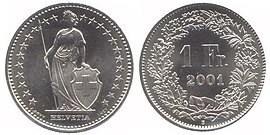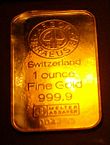Swiss franc
| Swiss franc | |
|---|---|
| Country: |
|
| Subdivision: | 100 cents |
| ISO 4217 code : | CHF |
| Abbreviation: | Fr. |
|
Exchange rate : (August 27, 2020) |
EUR 1.– = CHF 1.075 |
- Banknotes of the 9th series from 2016
- Current coins minted in 1995
The Swiss franc , Swiss High German and Swiss franc written ( Swiss German Schwiizerfranke , French Suisse Franc , Italian Franco svizzero , Romansh ) is the currency of the Swiss Confederation and the Principality of Liechtenstein . It is issued by the Swiss National Bank and is divided into 100 cents ( French Centimes , Italian Centesimi , Rhaeto-Romanic rape ). Its abbreviation according to ISO 4217 is CHF , according to Art. 1 MünzV in German Fr. , in the other languages fr. , The abbreviation Rp. (French c. , Italian ct. , Rhaeto-Romanic rp. ) is used for cents . The decimal separator in the currency is a point, the currency abbreviation is added in front (e.g. Fr. 12.35 or CHF 12.35).
In addition, the Swiss franc is the official currency in the Italian exclave Campione d'Italia . In Büsingen am Hochrhein , the German exclave in Switzerland, most payments are made in Swiss francs, although the euro is legal tender.
history
prehistory
Until the founding of the Helvetic Republic in 1798, the issue of coins was the responsibility of the cantons (towns) , cities, abbeys and individual rulers. In 1798 the French introduced a unified franc currency (French: "franc de Suisse"). One franc was the equivalent of 10 Bernese chunks or 6.614 grams of pure silver or 1.4597 French francs . The currency was divided into 10 chunks or 100 cents. The previously used as invoice currency z. The crown held in Bern, for example, was equivalent to 25 lumps.
With the mediation of 1803, mint sovereignty returned to the cantons. However, the daily charter set the Swiss franc (now set at 6.77025 grams of fine silver or 1.5 French francs) as the single currency. The cantons' Kurant coins were based on this unit, while the divisional coins were often still minted in the old units.
Introduced in 1850
After Switzerland was created as a federal state in 1848, the federal government became responsible for the currency. With the "Federal Law on Federal Coinage" of May 7, 1850, the franc, which was now based on the French (silver) franc, was introduced as the currency of Switzerland. The introduction was preceded by a great debate about the connection to the French system of the franc or the southern German system of the guilder , with French-speaking Switzerland and Basel in favor of the connection to France and German-speaking Switzerland in favor of the southern German model. From 1850 new coins were minted and issued the following year. The signature of the important Swiss sculptor , coin engraver and medalist Antoine Bovy (A. BOVY) is on the edge of the coin image of the Swiss Francs from 1850 and 1851 .
Latin Monetary Union (1865–1927) and the Great Depression
From 1865 to 1927 Switzerland was a member of the Latin Monetary Union , which meant that gold and silver coins from France, Belgium, Italy and Greece circulated as official currency in Switzerland. The provisions of the Coin Union stipulated that the unit of the respective national currency was equivalent to 4.5 grams of silver or 0.290322 grams of gold. Even after the union had become meaningless in the 1910s and officially ended in 1927, the gold parity for the Swiss franc remained until it had to be devalued by 30 percent in 1936 as a result of the global economic crisis .
The exchange rate against the mark , established as part of the gold standard , was 0.81 in 1912 and was still unchanged in 1932.
Bretton Woods System (1949–1973)
From 1945 until the collapse of the Bretton Woods system in 1973, the Swiss franc was pegged to the US dollar . The exchange rate was 4.30521 francs per dollar from 1945 to 1949, 4.375 francs per dollar from 1949 to 1973 and 0.203125 g gold per franc. Since then, the dollar has always lost value.
1973-2011
Due to its flexible exchange rate , the Swiss franc has been a stable and crisis-proof currency since the collapse of the Bretton Woods system , which has benefited from the development of the Swiss economy. Investors' trust in Switzerland as a financial center and in the country's economic and political stability made the Swiss franc a coveted investment currency that is widely used internationally. In the past, the Swiss franc had proven to be a “safe haven” for international investors when the world was shaken by political or economic disasters. This confidence was expressed in the upward pressure on the exchange rate of the franc due to increasing demand on the international financial markets .
Fixed minimum exchange rate (2011-2015)
The Swiss National Bank (SNB) set a minimum exchange rate of EUR 1.– = CHF 1.20 in September 2011 due to the prolonged overvaluation of the Swiss franc. On January 15, 2015, it lifted the minimum exchange rate with immediate effect.
Causes and Fixing (2011)
Caused by the outbreak of the euro crisis in the PIIGS countries (from May 2010) and the high national debt of the United States , the Swiss franc was in very high demand from international investors . From May 2010 to the beginning of August 2011 alone, the exchange rate of the Swiss franc rose by over 30% against the euro and by over 25% against the US dollar. The Swiss National Bank (SNB) tried various measures to stop the overvaluation of the Swiss franc, as the increasingly higher valuation of the national currency burdened the export-oriented economy and carried the risk of deflation . In 2009 and 2010 foreign securities were bought up, then in 2011 the key interest rate was lowered and the money supply increased. In September 2011, the SNB finally announced unlimited foreign exchange purchases in order to achieve the target price of at least 1.20 francs per euro.
National Bank sets a minimum exchange rate of 1.20 francs per euro:
The current massive overvaluation of the Swiss franc poses an acute threat to the Swiss economy and carries the risk of a deflationary development. The Swiss National Bank is therefore aiming for a clear and permanent weakening of the Swiss franc. With immediate effect, it will not tolerate a euro-franc rate below the minimum rate of 1.20 on the foreign exchange market. The National Bank will forcefully enforce the minimum exchange rate and is ready to buy unlimited foreign currency. The franc is also highly valued at 1.20 per euro and should continue to weaken over time. If the economic outlook and deflationary risks so require, the National Bank will take further measures.
Abolition of the minimum exchange rate (2015)
On January 15, 2015, the minimum exchange rate of 1.20 Swiss francs per euro introduced in September 2011 was lifted by the Swiss National Bank (SNB). At the same time, the negative interest rate for balances on current accounts that exceed a certain allowance was increased by 0.5 percentage points to −0.75%. As of January 15, 2015, the Swiss central bank will shift the target range for the three-month Libor into the negative range from −0.75% to 0.25% to −1.25% to −0.25%. The SNB had already announced the introduction of negative interest rates in December 2014.
Reasons for cancellation
The SNB justified the abolition of the minimum exchange rate that had been in place for more than three years with the significant depreciation of the euro against the US dollar, which was associated with a weakening of the Swiss franc against the US currency. In view of the development of monetary policy in the United States and the euro area , the Swiss National Bank came to the conclusion that the enforcement and maintenance of the minimum exchange rate was no longer justified.
The background to the decision by the SNB was the pending of the first rate hike in the United States since the financial crisis and the expected easing of monetary policy by the European Central Bank (ECB). It was known that the ECB would decide on January 22, 2015 on a program for the broad-based purchase of government bonds based on the American model. It was to be feared that the deliberate weakening of the euro through a monetary policy of quantitative easing (QE) on the part of the ECB would lead to an inflow of large amounts of liquidity into the financial system - with the franc as a “natural drainage basin”. In particular, the fixed exchange rate of 1.20 Swiss francs per euro made it possible to expect high inflows of liquidity.
After the euro was traded on the money market at a price of 1.25 US dollars in December 2014, inflation expectations in Europe fell and the euro continued to lose value. In view of falling inflation expectations and increasing devaluation, however, a weak euro is unsuitable as a reference currency for the Swiss franc. Since this did not go unnoticed on the money market, in December 2014 the SNB had to intervene again in the Swiss currency for a long time . In extreme cases, the SNB would have been forced to put Swiss francs on the market far beyond what is politically justifiable. In addition, losses on foreign exchange holdings would also mean that no more money could have been distributed to the Confederation and the cantons of Switzerland.
In view of these risks, which the SNB considered too great compared to the economic advantages of a fixed exchange rate, the Swiss central bank decided to release the euro exchange rate. Ultimately, the increasing flow of money in the foreign exchange market , which began in December 2014, made this decision by the Swiss National Bank necessary. In the days before the minimum euro exchange rate was abolished, not a day went by without major interventions. In January, an extrapolated CHF 100 billion would have had to be spent to maintain the minimum exchange rate. This amount was determined by extrapolation and based on the increasing sums of the SNB's interventions in the days before the lifting.
The SNB itself had initially justified the abolition of the minimum exchange rate in a media release with the following words:
“The differences in the monetary policy orientation of the major currency areas have increased markedly recently and are likely to become even more pronounced. The euro has depreciated significantly against the US dollar, which means that the Swiss franc has also weakened against the US dollar. Against this background, the National Bank has come to the conclusion that the enforcement and maintenance of the minimum euro-franc exchange rate are no longer justified. "
On the afternoon of the same day, SNB President Thomas Jordan personally defended the Swiss National Bank's reasons and approach in a press conference. SNB director Fritz Zurbrügg justified both in detail in an interview he gave to the Swiss newspaper “ Blick ” on January 22, 2015. He cited the drifting apart of the economies of the European Union and the economies of the United States as the reason for the sudden release of the exchange rate . The strong appreciation of the US dollar had led to a correspondingly strong depreciation of the Swiss franc against the US currency. The reason for the devaluation of the Swiss currency was the coupling of the minimum rate of the Swiss franc to the euro / US dollar exchange rate. «Against this background, the minimum rate was no longer justified. It could only have been maintained with very high interventions. " so Fritz Zurbrügg literally. The intervention amounts necessary to maintain the minimum exchange rate in the days prior to the decision of the SNB Governing Board grew steadily. Projected over a month, an amount of 100 billion Swiss francs would have been necessary in January alone. Such interventions by the central banks lead to major global economic distortions. If the SNB had stuck to the minimum exchange rate, the central bank balance sheet of the Swiss central bank would have increased so much that it would run the risk of losing control of its monetary policy in the long term. → Further information under: Weblinks
Consequences of the repeal
Global foreign exchange market
After the removal of the minimum euro rate, the euro to Swiss franc exchange rate plummeted immediately. At times the euro was below one franc. At 11 a.m., 1 euro was traded at 1.05 francs on the foreign exchange market. The price of the US dollar became cheaper. Before the exchange rate was released, 1.02 Swiss francs (CHF) per US dollar (USD) had to be paid, after that it was only CHF –.86 per USD. Immediately after the exchange rate was released , at least two currency traders went bankrupt : the New Zealand currency trader Global Brokers on January 15, 2015 and the British currency trader Alpari on January 16, 2015. According to Alpari , the decision of the SNB resulted in extreme exchange rate fluctuations and “drying up any liquidity »And consequently led to losses for the majority of corporate customers that exceeded their deposit capital. The forex trader was responsible for any losses not covered by the customer. The foreign exchange trader Global Brokers , who had been affected in the same way , announced that it was no longer able to meet the requirements of the financial supervision due to losses and liquidity problems , but assured its customers that their deposits were safe. The largest US currency trader and online broker for retail investors, FXCM, reported customer losses of $ 225 million, other traders of tens of millions of dollars. After FXCM's share price fell more than 70%, the company was bailed out with an emergency loan of $ 300 million. Forex traders in the United States only need to cover two percent of the amount traded, as currencies typically don't fluctuate as much as stocks . Customer losses in excess of customer deposits must also be recovered by the currency dealer in the United States. The Wall Street Journal reported on the night of March 16-17. January 2015 with reference to initiated circles that the Deutsche Bank must expect massive losses of around 150 million US dollars, as well as the US major bank Citigroup in the same order of magnitude. The British bank Barclays and some hedge funds are said to have suffered significant losses.
In Switzerland, the stock market collapsed immediately after the abrupt abolition of the minimum CHF / Euro exchange rate , while other European stock markets got into turmoil but then calmed down again. Many investors suffered double-digit million losses on the Swiss stock exchange within two days. Individual stocks temporarily lost over 20 percent of their value.
Switzerland
After the Swiss franc was released, the number of overnight stays in Swiss hotels fell by 7.4 percent in March 2015. 14.5 percent of the European visitors and 15.9 percent fewer of the German tourists stayed in the country's hotels.
Real gross domestic product (GDP) in Switzerland contracted by 0.1 percent in the third quarter of 2015 and grew by 0.4 percent in the following quarter.
Germany
As of November 2014, German private individuals were in debt with a total of 7.2 billion Swiss francs, companies with 5.2 billion, public households with a total of around 1.78 billion Swiss francs. An unsecured foreign currency loan was even recommended to the municipalities by the municipal examination institute, despite the inevitable currency speculation.
| Local authority | Loan amount | Additional charge in euros |
|---|---|---|
| City of Bochum | EUR 180 million | 30 million |
| City of Burglengenfeld (municipal operations) | > CHF 30 million | 3.7 million |
| City of Essen | CHF 450 million | 75 million compared to the beginning of the year, 160 million since borrowing |
| City of Gladbeck | EUR 64 million | |
| City of Ingolstadt | CHF 33 million | paid 1.2 million for the exit |
| City of Lünen | 21 million | |
| City of Munster | CHF 102 million | 0.5 million euros annually |
| District of Osnabrück | EUR 19.6 million | |
| City of Osnabrück | CHF 49.4 million | 7.3 million compared to the beginning of the year |
| Rheingau-Taunus district | EUR 185 million | |
| City of Waltrop | 5 million |
Reasons for borrowing in foreign currency :
- The city of Münster wanted the interest rate risk u. a. by taking out their loans in different currencies. Fifteen percent of municipal loans were allowed to be raised in Swiss francs, a currency that offered up to two percent interest advantage until the exchange rate was released and was judged to be stable over the long term.
Austria
Private households and companies hold loans in Swiss francs of over 29 billion euros. The state of Salzburg is now liable for a Swiss franc loan from the local exhibition company due to the rise in the exchange rate of the Swiss franc with 27 instead of 15 million euros.
Eastern Europe
The sudden release of the exchange rate has made it more expensive for tens of thousands of Eastern Europeans to take out real estate loans in Swiss francs by almost a fifth. Many are threatened with losing their home. Even before the minimum exchange rate was abolished, high losses in the rate of Eastern European currencies against the Swiss franc resulted in higher interest rates than planned by the borrowers when repaying the loans . Many were threatened with insolvency even before the minimum exchange rate was given up .
Bosnia and Herzegovina
Although only 9,000 homeowners are in debt in Bosnia and Herzegovina , they also fear that they will not be able to make due installments on time. According to the economics professor Goran Radivojac from Banja Luka, the borrowers' payment difficulties escalated before the minimum exchange rate was fixed because many of the borrowers estimated the costs to be lower than later found out.
Croatia
Around 60,000 property owners in Croatia have taken out loans in Swiss francs. In the meantime, Croatia's parliament decided on a proposal by the government to make things easier for Swiss franc borrowers. A fixed exchange rate for the Swiss franc to the Croatian kuna of 6.38 kuna per Swiss franc has been set in the Consumer Credit Act.
Poland
As of 2004, hundreds of thousands of Poles had taken out mortgage and consumer loans in Swiss francs. According to official information, 700,000 Poles, or up to 1.5 million according to pessimistic estimates, have borrowed from these types of loans, 566,000 of them from mortgage loans. With an average monthly earnings of 3800 złoty , the borrowers now have to pay back a little more than 2400 złoty per month as an interest rate to the lender instead of 2000 złoty . According to financial experts, seven percent of mortgage loans were already at risk in 2014. On January 15, 2015, the exchange rate changed within a few minutes from 3.55 zloty to 5.19 zloty per Swiss franc; the exchange rate reached its historic low in July 2008 at 1.98 zloty per Swiss franc. Just the day before, the Polish Financial Supervisory Authority had assessed an exchange rate of five zlotys per Swiss franc as harmless to the stability of the Polish banking system. Nevertheless, the stock exchange prices of the Polish banks Gentin Noble and Millineum on the Warsaw Stock Exchange plummeted after the exchange rate was released. These had granted up to 40% of their loans in Swiss francs.
Romania
In Romania , there were hardly any apparently cheap, but risky, loans in Swiss currency to homeowners. The share of such loans in the total loan volume in Romania is only 5%.
Serbia
In Serbia , 22,000 borrowers fear an oath of disclosure and foreclosure of their property. The Serbian Bank Customers Association Efektiva calculated that anyone who took out a loan of 43,000 Swiss francs in 2008 is now in debt with 60,000 euros. Serbia's former head of the National Bank, Radovan Jelašić, had already warned in vain in 2007 against subsidizing real estate loans in Swiss francs, as he feared that this would expose borrowers to an increased risk.
Czech Republic
In the Czech Republic , too , hardly any loans were granted in Swiss currency. The share of the total loan volume is only 0.02%.
Hungary
In contrast to borrowers in other Eastern European countries, borrowers in Hungary were not affected by the changed exchange rate of the forint to the Swiss franc. The government of Prime Minister Viktor Orbán ordered the compulsory conversion of all real estate loans taken out in foreign currency in November 2014.
Gold price
After the Swiss franc was traded against the euro without a minimum exchange rate, the gold price rose by 35 US dollars to as much as 1264 US dollars per troy ounce of gold, the highest level since September 2014. According to traders, this could be due to two reasons. Since the dollar lost value not only against the Swiss franc but also against other currencies after the minimum euro exchange rate ceased to exist, and gold is traded in the US currency, it tends to be cheaper for investors to buy than before. In addition, the expectation of a sustained loose monetary policy by many central banks is boosting demand for the precious metal. Due to the associated low interest rates , gold is attractive for investors, although the precious metal does not generate any interest.
Swiss francs outside of Switzerland
In 1924, the Swiss franc was also introduced in Liechtenstein , where it replaced the Austrian crown and Liechtenstein emergency money . However, Liechtenstein did not conclude an official currency treaty with Switzerland until June 19, 1980 ("Currency treaty between the Swiss Confederation and the Principality of Liechtenstein").
The official currency of the Italian exclave Campione d'Italia is the Swiss franc. The German exclave Büsingen on the Upper Rhine uses the euro as the official currency; Most of the time, however, the Swiss franc is used for trading.
As a reserve currency , the Swiss franc plays a rather subordinate role.
Since several international sports federations have their headquarters in Switzerland, in many sports prize money is paid out in Swiss francs or fines are imposed in Swiss francs.
Coins
Circulation coins
The Swiss coins are produced by the official Swissmint (formerly the Federal Mint ).
The nominal values, the diameter, the weight, the edge embossing as well as the alloy are determined by the Federal Council ( Art. 2 MünzV ), the FDF defines the tolerance limits with regard to dimensions and the alloys.
The following coins are still minted today:
| amount | image | motive | metal | diameter | thickness | Dimensions | Edge embossing | Manufacturing costs | Nicknames |
|---|---|---|---|---|---|---|---|---|---|
| 5 cents |

|
Libertas head (often interpreted as Helvetia ) |
92% Cu , 6% Al , 2% Ni | 17.15 mm | 1.25 mm | 1.8 g | smooth | 4.22 Rp. | Fünferli, Halbbatzen, Füfi |
| 10 cents |

|
Libertas head | 75% Cu, 25% Ni | 19.15 mm | 1.45 mm | 3 g | smooth | 6.63 Rp. | Zehnerli, lump, tooth |
| 20 cents |
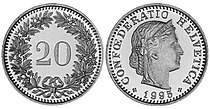
|
Libertas head | 75% Cu, 25% Ni | 21.05 mm | 1.65 mm | 4 g | smooth | 8.47 Rp. | Zwanzigerli, Zwänzgerli, Zweibätzler, Zwänzgi |
| ½ franc |

|
Standing Helvetia | 75% Cu, 25% Ni | 18.20 mm | 1.25 mm | 2.2 g | ribbed | 7.10 rp. | Fufzgerli, Füfzgerli, Füfzgi |
| 1 franc |

|
Standing Helvetia | 75% Cu, 25% Ni | 23.20 mm | 1.55 mm | 4.4 g | ribbed | 9.93 rp. | Egg fränkler |
| 2 francs |

|
Standing Helvetia | 75% Cu, 25% Ni | 27.40 mm | 2.15 mm | 8.8 g | ribbed | 19.40 Rp. | Two-sided |
| 5 francs |
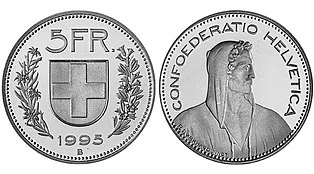
|
Alp hirt (often interpreted as Wilhelm Tell ) |
75% Cu, 25% Ni | 31.45 mm | 2.35 mm | 13.2 g | ★★★ DOMINUS PROVIDEBIT ★★★★★★★★★★
(from 1985 to 1993 deepened, otherwise protruding) |
36.30 Rp. | Fünfliber, Fünffränkler, Göttibatzen, Schnägg |
The edge is smooth for 5, 10 and 20 centimes, ribbed for ½, 1 and 2 francs and with stars and the inscription "DOMINUS PROVIDEBIT" for 5 francs. The German translation of the Latin inscription is: The Lord will provide. It is a biblical quote from the story of the sacrifice of Isaac .
The one and two rappers are out of course and no longer shaped .
The name of the country is indicated on all coins with “Confoederatio Helvetica”, the Latin name of the Swiss Confederation, or “Helvetia”.
The oldest coins still valid today are the 10 centimes coins from 1879. Of all the circulation coins worldwide, they are by far the oldest that are still produced today with the same motif and the same alloy.
The 2-franc coins - as the oldest - have been minted with the same motif since 1874 until today. However, the editions up to 1967 were withdrawn due to their silver alloy (today: cupernickel), as the silver alloy exceeded the nominal value. The same thing happened at the same time with all coin values from 50 cents upwards (exception: in 1969 there were again 5-franc coins made of silver). Coins worth around 350 million francs were melted down at home and abroad during this period. Since 2004, the pure nickel coins of 10 (1932–1939) and 20 cents (1881–1938) have been withdrawn from circulation because machines cannot recognize them.
Today all coins with the exception of the 5 centimes coin ( aluminum bronze since 1981 ) are alloyed in cupronickel.
The one-centime piece , which has not played a role in payment transactions for a long time and whose production costs were most recently 11 centimes, was suspended on January 1, 2007. The two - centime piece , which was minted until 1974, was withdrawn from payment transactions as early as 1978. At the same time as the abolition of the Einräpplers, the abolition of the Fünfräpplers was discussed. Since the reactions to this were mostly negative and, among other things, a price increase was feared, these plans were dropped.
Commemorative coins
Switzerland has been issuing commemorative coins occasionally since 1936 and annually since 1974 . Until 1991, these were five-franc coins, the technical data of which were identical to the current coins and were valid for the exchange rate, even if they were rarely found in payment transactions. Today, denominations of 10 francs ( bimetal ), 20 francs (20 g silver-copper alloy) and 50 francs (11.29 g gold-copper alloy, is only sold above the face value) are minted. Their face value is guaranteed by law, but they are not approved for general payment transactions.
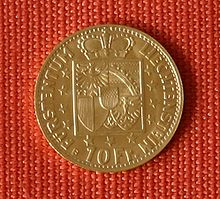
The "Currency Treaty Switzerland - Liechtenstein" of 1981 allows Liechtenstein, with the approval of the Federal Department of Finance (FDF), to mint its own coins and put them into circulation. This enables Liechtenstein to mint commemorative coins on special occasions. For the 200th anniversary of the sovereignty of the Principality in 2006, two types of coins with a face value of 10 and 50 francs were minted. However, these are only valid as a means of payment in Liechtenstein.
Banknotes
Banknotes were first issued by commercial and cantonal banks ; In 1907, the newly founded Swiss National Bank (SNB), as the central bank, was given the sole right to issue banknotes (note monopoly). The first series (interim notes) , which was introduced immediately, was based on drafts from abroad, supplemented by Swiss national emblems. In 1909 Orell Füssli printed banknotes for the SNB on a trial basis, which were produced by several printing works based on domestic drafts and introduced by the SNB as a second series from 1911. In the 1970s, with the sixth series, Orell Füssli's security printing department became the sole printing company for all Swiss banknotes. The production costs of the 8th series were around 30 centimes per banknote.
Liechtenstein has never issued banknotes in Swiss francs and has no right to do so under the current Swiss-Liechtenstein currency treaty.
Tabular overview
| series | introduction | recall | exchangeable until | Designer | Remarks |
|---|---|---|---|---|---|
| 1. | 1907 | 07/01/1925 | 07/01/1945 | Josef Storck and Albert Walch | Transition grades |
| 2. | 1911 | 10/01/1958 | 10/01/1978 | Eugène Burnand , Ferdinand Hodler and S. Balzer | the 5-franc note was only recalled in 1980 and lost its validity in 2000 |
| 3. | 1918-1930 | 1925/1956 | 1945/1976 | Orell Füssli | so-called war notes, only 2 notes issued |
| 4th | (1938) | - | - | Victor Surbek and Hans Erni | Reserve series, never circulated |
| 5. | 1956-1957 | 05/01/1980 | 05/01/2000 | Pierre Gauchat and Hermann Eidenbenz | |
| 6th | 1976-1979 | 05/01/2000 | unlimited | Ernst and Ursula Hiestand | |
| 7th | (1984) | - | - | Elisabeth and Roger Pfund | Reserve series, never circulated |
| 8th. | 1995-1998 | no recall date defined | unlimited | Jörg Zintzmeyer | replaced by the 9th series |
| 9. | 2016-2019 | unlimited | Manuela Pfrunder | in circulation |
The banknotes are valid as legal tender until they are recalled, after which they can be exchanged at their face value at the Swiss National Bank. There were different deadlines for this. In 1921 a period of 20 years from the recall was introduced. From the 6th series onwards, the banknotes no longer lose their value, but can be exchanged without a time limit.
Validity of the banknotes
Since 2020, starting with the sixth series of banknotes from 1976, all banknotes can be exchanged at the National Bank for an unlimited period of time at face value even after they have been recalled. Until the end of 2019, the rule was that after the issue of the last note value of a new series, the Swiss National Bank would announce the recall of the old series. After that, the banknotes could be exchanged at face value at the National Bank for another twenty years, after which the notes were worthless.
In April 2017, the Swiss Federal Council, in agreement with the Swiss National Bank, proposed that the exchange period for old banknotes be lifted. The Swiss Council of States did not initially accept this proposal, as it would have meant that the cantons would have had to forego revenue. Until then, the National Bank had paid the equivalent of the unexchanged notes into the Swiss fund for assistance in the event of non-insurable damage caused by natural forces ( Fondssuisse ). The Council of States suggested, however, that only a fifth of this should go to the fund and the rest should be distributed to the federal government and two thirds to the cantons. In June 2019, the Council of States gave in, so that since then banknotes from the sixth series - as in many other countries - can be exchanged for an unlimited period of time. The law revision came into force on January 1, 2020 ( Art. 9 Paragraphs 3 and 4 WZG ).
Banknote series
All of the sheet music images of all series below are true to scale.
First series from 1907
The first series consisted of the notes: 50, 100, 500 and 1000. The 1000 franc banknote was a very high value for the time. According to today's purchasing power, it would be equivalent to a banknote worth 11,800 francs. When the National Bank was founded in 1907, the notes were issued as “interim notes”, as there was too little time between the establishment of the National Bank and the issue of notes to create new notes. 1st edition: June 20, 1907, recalled: July 1, 1925, valid until: June 30, 1945.
The copper plates come from Bradbury Wilkinson and Company in London, the letterpress and numbering was done by Stämpfli & Co. , the copperplate printing took place at Benziger in Einsiedeln .
| amount | front | back | portrait | motive | Format in millimeters |
Issue date |
|---|---|---|---|---|---|---|
| CHF 50 |

|

|
Helvetia | Ornaments | 103 × 166 | June 20, 1907 |
| CHF 100 |

|

|
Helvetia | Ornaments | 116 × 183 | June 20, 1907 |
| CHF 500 |
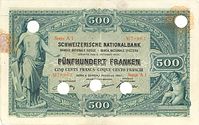
|

|
Helvetia | Ornaments | 126 × 199 | June 20, 1907 |
| CHF 1000 |
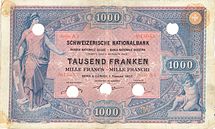
|
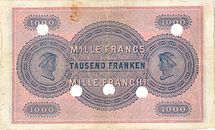
|
Helvetia | Ornaments | 132 × 215 | June 20, 1907 |
Second series from 1911
The second series from 1911 consisted of the notes 5, 10, 20, 40, 50, 100, 500 and 1000. The series was valid for more than 67 years, but the 10 and 40 notes were never in circulation. 1st edition: September 16, 1911, recall: October 1, 1958, valid until: September 30, 1978. The 5-note was only recalled on May 1, 1980 and was valid until April 30, 2000.
The 1000, 500, 100, 50 and 10 series were printed at Waterlow in London . The 40, 20 and 5 notes were printed by Orell Füssli .
| amount | front | back | portrait | motive | Format in millimeters |
Issue date |
|---|---|---|---|---|---|---|
| Fr. 5 |

|

|
William Tell | Ornaments, rosette | 72 × 125 | August 3, 1914 |
| Fr. 10 |

|

|
Neuchâtel woman | Ornaments, rosette | 82 × 135 | - (reserve note) |
| Fr. 20 |

|

|
Vreneli | Ornaments, rosette | 95 × 163 | July 31, 1914 |
| CHF 40 |

|

|
Arnold Winkelried | Ornaments, rosette | 82 × 144 | - (reserve note) |
| CHF 50 |

|

|
Woman's head in a medallion | Lumberjack ( Ferdinand Hodler ) | 106 × 165 | December 22, 1911 |
| CHF 100 |

|

|
Woman's head in a medallion | Mower ( Ferdinand Hodler ) | 115 × 181 | September 16, 1911 |
| CHF 500 |

|

|
Woman's head in a medallion | Hand embroiderers ( Eugène Burnand ) | 125 × 200 | December 24, 1912 |
| CHF 1000 |

|

|
Woman's head in a medallion | Foundry ( Eugène Burnand ) | 131 × 216 | September 16, 1911 |
Third series from 1918
The third series consisted of several notes that were written between 1918 and 1930 as "war notes". It consists of three different 20s and two different 100s, only one of which was issued.
The issued 100 note was recalled on July 1, 1925 and worthless on July 1, 1945. The 20 note was recalled on April 1, 1956 and worthless on April 1, 1976.
| amount | front | back | portrait | motive | Format in millimeters |
Issue date |
|---|---|---|---|---|---|---|
| Fr. 20 |

|

|
Johann Heinrich Pestalozzi | Swiss cross | 86 × 143 | July 15, 1930 |
| Fr. 20 |

|

|
Johann Heinrich Pestalozzi | Swiss cross | 86 × 143 | - (reserve note) |
| Fr. 20 |

|

|
From Freiburg | Ornaments and rosette | 88 × 141 | - (reserve note) |
| CHF 100 |
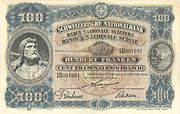
|

|
William Tell | Ornaments, rosette and Jungfrau massif | 115 × 180 | September 27, 1918 |
| CHF 100 |

|

|
William Tell | Ornaments, rosette and Jungfrau massif | 115 × 180 | - (reserve note) |
Fourth series from 1938
The fourth series consisted of the notes 50, 100, 500 and 1000. It is a reserve series that was printed by Orell Füssli . It was never issued. In the case of the 500 note, it was only a proof. The 50, 500 and 1000 notes were designed by Hans Erni , the 100 by Victor Surbek .
| amount | front | back | portrait | motive | Format in millimeters |
Issue date |
|---|---|---|---|---|---|---|
| CHF 50 |

|

|
Woman's head in a medallion | bull | 96 × 167 | - |
| CHF 100 |

|
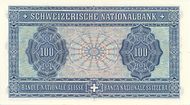
|
Haslitalerin in a medallion | Ornaments, rosette and numeral of value | 106 × 190 | - |
| CHF 500 |
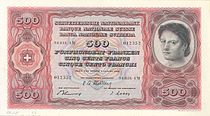
|

|
Woman's head in a medallion | chemistry | 116 × 210 | - |
| CHF 1000 |
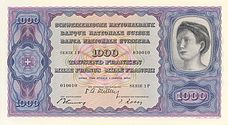
|

|
Woman's head in a medallion | turbine | 125 × 228 | - |
Fifth series from 1956
The fifth series consisted of notes 10, 20, 50, 100, 500 and 1000. 1st edition: staggered from March 29, 1956, recall: May 1, 1980, valid until: April 30, 2000.
The 10 and 20 notes were designed by Hermann Eidenbenz and printed by Orell Füssli in Zurich, the higher-quality notes were designed by Pierre Gauchat and were printed by Waterlow and De La Rue .
| amount | front | back | portrait | motive | Format in millimeters |
Issue date |
|---|---|---|---|---|---|---|
| Fr. 10 |

|

|
Gottfried Keller | Clove root | 75 × 137 | October 1, 1956 |
| Fr. 20 |

|

|
Henri Dufour | Silver thistle | 85 × 155 | March 29, 1956 |
| CHF 50 |

|

|
Girl head | Apple harvest | 95 × 173 | June 14, 1957 |
| CHF 100 |

|
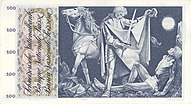
|
Boy's head | St. Martin | 105 × 191 | June 14, 1957 |
| CHF 500 |

|

|
Woman head | Fountain of youth | 115 × 210 | June 14, 1957 |
| CHF 1000 |
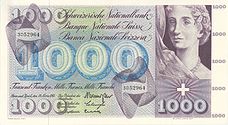
|
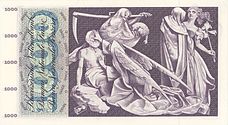
|
Woman head | Dance of death | 125 × 228 | June 14, 1957 |
Sixth series from 1976
The sixth series was designed by Ernst and Ursula Hiestand and printed by Orell Füssli in Zurich. It consisted of the note values 10, 20, 50, 100, 500 and 1000 Swiss francs. The banknotes were issued in stages from October 4, 1976 and were recalled on May 1, 2000. The notes can be exchanged at the Swiss National Bank for their full face value without restriction.
| amount | front | back | portrait | motive | Format in millimeters |
Issue date |
|---|---|---|---|---|---|---|
| Fr. 10 |

|

|
Leonhard Euler | A water turbine , our solar system and the beam path in a lens system | 66 × 137 | 5th November 1979 |
| Fr. 20 |

|

|
Horace-Bénédict de Saussure | A mountain landscape, a group of mountaineers (probably after a work by Henri L'Evêque CH-NB - Monsieur Desaussure son fils & ses guides arivant au glacier du Tacul au grand Géant où ils ont habité 17 Jours Sous des Tentes en Juillet 1788 - graphics Location and landscape views - GS-GRAF-ANSI-F-39.tif ) and ammonites | 70 × 148 | April 4th 1979 |
| CHF 50 |

|

|
Conrad Gessner | an eagle owl , a primrose and stars | 74 × 159 | 4th October 1978 |
| CHF 100 |

|

|
Francesco Borromini | The bell tower and floor plan of Sant'Ivo alla Sapienza | 78 × 170 | 4th October 1976 |
| CHF 500 |

|

|
Albrecht von Haller | A schematic representation of breathing and a muscle figure | 82 × 181 | April 4th 1978 |
| CHF 1000 |

|

|
Auguste Forel | Three ants and the vertical section through an anthill | 86 × 192 | April 4th 1978 |
Seventh series from 1984
It was designed in the 1980s and formed the reserve series. The appearance and the dates of these banknotes were not intended for the public (so-called secret reserve ). The notes of this series would have been used if the notes currently in circulation had been forged en masse. It was the last reserve series. Instead of a reserve series, the safety system was continuously developed in the eighth series. Meanwhile, the appearance of the seventh series has also been released. In this series, the same people are depicted (albeit according to different templates) as in the sixth series, with the exception of Auguste Forel , who was replaced by Louis Agassiz .
| amount | front | back | portrait | motive | Format in millimeters |
Issue date |
|---|---|---|---|---|---|---|
| Fr. 10 |

|

|
Leonhard Euler | The gamma function , our solar system and a table of numbers | 66 × 137 | no issue |
| Fr. 20 |

|

|
Horace-Bénédict de Saussure | A hygrometer and the Montblanc | 70 × 148 | no issue |
| CHF 50 |

|

|
Conrad Gessner | A golden eagle , an animal metamorphosis and a Latin text | 74 × 159 | no issue |
| CHF 100 |

|

|
Francesco Borromini | The floor plan of San Carlo alle Quattro Fontane , the spire of Sant'Ivo alla Sapienza and a dove of peace | 78 × 170 | no issue |
| CHF 500 |

|

|
Albrecht von Haller | An 18th century anatomy chart and an x-ray of the human chest | 82 × 181 | no issue |
| CHF 1000 |

|

|
Louis Agassiz | The head and skeleton of a perch | 86 × 192 | no issue |
Eighth series from 1995
The eighth series of banknotes, which was introduced in 1995, comprises six denominations (face values) with portraits of Swiss cultural workers, a significant part of whom had worked abroad. The notes were issued between 1995 and 1998. The notes are still legal tender.
| amount | front | back | portrait | motive | Format in millimeters |
Issue date |
|---|---|---|---|---|---|---|
| Fr. 10 |

|

|
Le Corbusier (architect) | Floor plan of the government district of the Indian city of Chandigarh | 74 × 126 | April 8, 1997 |
| Fr. 20 |

|

|
Arthur Honegger (composer) | Pacific 231 | 74 × 137 | October 1, 1996 |
| CHF 50 |

|

|
Sophie Taeuber-Arp (visual artist) | Tete Dada, 1919 | 74 × 148 | October 3, 1995 |
| CHF 100 |

|

|
Alberto Giacometti (visual artist) | L'Homme qui marche I. | 74 × 159 | October 1, 1998 |
| CHF 200 |

|

|
Charles-Ferdinand Ramuz (writer) | Lac de Derborence / Diablerets , Lavaux | 74 × 170 | October 1, 1997 |
| CHF 1000 |

|

|
Jacob Burckhardt (art historian) | Palazzo Strozzi , Florence (detail from the facade) | 74 × 181 | April 1, 1998 |
These notes replaced the previous series from 1995 to 1998. A 500-franc banknote was not issued, but a new banknote worth 200 francs was introduced.
Ninth series of 2016
The ninth series of banknotes was introduced gradually from April 2016 to September 2019. Manuel Krebs won the design competition, but the runner-up Manuela Pfrunder was commissioned to continue her design. Autumn 2010 was originally planned as the date for the introduction. In order to have more time for the development of new security technologies, the date was initially postponed to 2012, as the current banknote series does not yet have a security deficiency. In February 2012, the SNB announced a further delay of at least one year due to technical problems.
At the end of 2012 the issue date was changed again; the introduction is now to take place in the period from April 2016 to 2019.
The first to be presented to the public at a media conference on April 6, 2016, was the new 50 note, which was issued from April 12, 2016. It was voted the most beautiful note of 2016 by the International Banknote Society. The remaining notes were put into circulation every six months or a full year.
| amount | front | back | motive | Format in millimeters |
Issue date |
|---|---|---|---|---|---|
| Fr. 10 |

|

|
Time, the organizing side of Switzerland: Front: a pair of female hands with a baton directing the beat; Kaleidoscope pattern: dials; the globe around the date line : end of day (Pacific, Bering Strait), time zones are shown; Safety strip: The Swiss railway network is shown on the safety strip, and the longest railway tunnels in Switzerland are also listed in kilometers. Back: Two tracks are merged by means of a splitting switch in the Lötschberg base tunnel ; Clockwork : stands for a well-functioning organization; The lines are sketches of the Swiss, Austrian and parts of the Hungarian railway network. |
70 × 123 | 18th October 2017 |
| Fr. 20 |

|

|
Light, the creative side of Switzerland: Front: a boyish right hand holds a prism in a beam of light so that the light is fanned out into different colors; Kaleidoscope pattern: The background of the note is reminiscent of a look through a kaleidoscope, in which colorful effects are created by the reflection of light; Globe four hours earlier (Pacific, North America), above which the light is reflected in constellations of stars; Safety stripes: the map of Switzerland and the surrounding regions shows the light emissions at night and the distance between various celestial bodies and the earth is listed in light seconds. Back: A light projection onto the large film screen on the Piazza Grande in Locarno during the Locarno Film Festival ; Butterfly : The light makes the colors of the butterfly and the many facets of nature tangible; The lines on the back of the 20 note show an iris that regulates the incidence of light into the human eye. |
70 × 130 | 17th May 2017 |
| CHF 50 |

|

|
Wind, the adventurous side of Switzerland: Front: a left hand is holding a ripe dandelion blossom in the wind, which blows away achenes ; Background pattern: wind arrows; Globe another four hours earlier (Atlantic, North and South America) and the wind arrows on the globe show the directions of the winds that connect Switzerland to other regions and continents; Safety strip: The Alpine massif is shown on the safety strip and the main peaks of the Swiss Alps are over 4000 m above sea level. M. are listed by name, from A for Aletschhorn to Z for Zumsteinspitze. Back: air currents flow around glacial alpine peaks and lead to up and down winds; Paraglider pilots ; Height curves illustrate the varied landscape of Switzerland. |
70 × 137 | April 12, 2016 |
| CHF 100 |

|

|
Water, Switzerland's humanitarian side: Front: a pair of hands holding out a cupped hand, offering water; Globe another four hours earlier (Atlantic, Europe, Africa, Middle East). Several rivers are listed with their length. Back: water flows along a vertical, but still vegetatively overgrown rock face in the dry Valais ; Suonen |
70 × 144 | September 12, 2019 |
| CHF 200 |

|

|
Matter, the scientific side of Switzerland: Front: a right hand indicates the three dimensions with the thumb, index finger and middle finger (see three-finger rule ); Globe another four hours earlier (Indian Ocean, Africa, Europe, Middle East, Russia, Asia) Back side: Particles pass through a particle detector of the LHC of CERN in Geneva ; Particle collision graphic |
70 × 151 | 22nd August 2018 |
| CHF 1000 |

|

|
Language, the communicative side of Switzerland: Front: Two hands extended to greet; Globe another four hours earlier: Start of the day (Indian Ocean, Asia, Australia, Pacific) Back: During the United Federal Assembly of Federal Councilors in the Federal Palace in Bern , speeches will be given in one of the national languages ; Graphic of a relationship network |
70 × 158 | March 13, 2019 |
Counterfeit security
The current banknotes of the ninth series are among the most counterfeit-proof in the world. They have up to 18 different security features to make counterfeiting almost impossible. The paper manufactured by Landqart is obtained from by-products of cotton processing (so-called liner ).
Specimen
If Swiss banknotes are reproduced, for example for use as test samples, play money or for advertising purposes, the imprint “SPECIMEN” (German: “Probe” / “Muster”) on the Swiss franc notes must be at least 75% and the width 15% of the banknote. The imprint can be omitted if it can be clearly distinguished from real notes by other features (such as size etc.).
The 1000-franc note as the "most expensive note"
The Swiss National Bank has been issuing the 1,000-franc banknote since the first series (1907). It has always been a banknote of extremely high value. In 1907, for example, the CHF 1,000 note had a current inflation-adjusted value of CHF 11,800.
From the better known currencies resp. Among the leading currencies, the 1000-franc note is by far the banknote in regular circulation worldwide with the highest value or the highest purchasing power, based on the exchange rate to other currencies. So z. For example, the current value of the highest euro banknote still in circulation is EUR 500 (= approx. CHF 540), the highest US dollar note still in circulation is 100 US $ (= approx. CHF 91.–), the highest pound sterling note issued by the Bank of England GBP 50.– (= approx. CHF 60.–) or the highest Japanese yen note JPY 10,000.– (= approx. CHF 86.–).
Taking into account all currencies, the 1,000-franc note is in regular circulation worldwide with the second-highest value or the second-highest purchasing power, after the 10,000- Brunei-dollar note (approx. 6,700 francs). If banknotes that are no longer issued and that are no longer in regular circulation but still valid are taken into account, there are “more expensive” banknotes in several other currencies. E.g. a 10,000 Singapore dollar note that has not been issued since 2014. In the case of the US dollar , banknotes with the values of US $ 1,000, US $ 5,000 and US $ 10,000 were issued until 1945 and were recalled in 1967, but they remain legal tender. Printed, never been in circulation, but legal tender is also a note with a value of US $ 100,000.
With the advent of electronic payments, the economic need for banknotes with a very high value / purchasing power decreased. Nonetheless, the circulation of the 1,000-franc note has increased steadily over the past few years: while 20 million "thousands" were still in circulation in 2004, in 2014 it was 38 million. Presumably, the 1000-franc note is increasingly being used for the physical storage of assets in safe deposit boxes or outside of financial institutions by people who distrust banks, want to avoid negative interest rates or - illegally - do not want to tax their assets. Cash is also preferred in the criminal environment, especially in organized crime, both for processing extremely expensive transactions (e.g. drug trafficking) and as an investment, for which the 1000-franc note seems particularly suitable. Since the Swiss franc is also considered a safe currency, the note is also attractive for foreign (non-Swiss) criminals. In order to combat money laundering, terrorist financing and drug trafficking, the 500 euro note was abolished in April 2019. In Switzerland, too, there were a few corresponding demands. However, since the Swiss are considered to be particularly cash-savvy and the effectiveness of the fight against crime is questionable, there are no specific intentions to abolish the 1,000 franc note, on the contrary: on March 13, 2019, only 2 months before the abolition of the 500 euro Note, the Swiss National Bank issued the 1,000 franc note for the first time in the current 9th series of banknotes
In parallel with the 1000-franc note as the “most expensive” banknote, the five -franc piece is one of the “most expensive” currency coins.
Banknotes in circulation
In 2017, the average banknotes in circulation was CHF 76,507,131,570. This sum was distributed over a total of 449,531,533 banknotes. The 1000-franc note accounted for the highest share in terms of value at 47,313,516,000 francs (61.8%). It can be concluded from this that a large proportion of cash is used as a store of value outside of payment transactions. In relation to the number of pieces, the 100-franc note was the most common: 125,486,986 banknotes of 100 francs were in circulation, which means 27.9% of the total number of Swiss banknotes.
Colloquial terms
In the colloquial language, the dialects of German-speaking Switzerland , the franc is often also called Stutz . There are various explanations for this; for example, a famous mint master in Fürth from Switzerland was called Conrad Stutz. According to another interpretation , stutz, stub or stump used to mean "exchange", "trade" or "squander". Another sloppy word is stone (Swiss German Stei ). For the colloquial names for the coins, see the table in the section Circulation coins .
In French-speaking countries , the colloquial term for the franc is balle (plural: balles ), which was also common in France for the French franc .
See also
literature
- Bernard Degen : Franconia. In: Historical Lexicon of Switzerland .
- Ernst Baltensperger : The Swiss Franc - A Success Story. The currency of Switzerland in the 19th and 20th centuries. NZZ Libro, Zurich 2012, ISBN 978-3-03823-793-8 .
Web links
|
Further content in the sister projects of Wikipedia:
|
||
|
|
Commons | - multimedia content |
|
|
Wiktionary | - Dictionary entries |
- Federal Act of December 22, 1999 on Currency and Means of Payment (WZG)
- Coin Ordinance of April 12, 2000 (MünzV)
- Currency treaty between the Swiss Confederation and the Principality of Liechtenstein
- Circulation coins. swissmint.ch
- Mint list - minting numbers of Swiss coins from 1850 onwards. Swissmint.ch
- All SNB banknote series on the website of the Swiss National Bank
- Short documentation of all 100-franc notes with an interview (PDF; 631 kB)
- Swiss coin catalog with illustrations
on the subject of the abolition of the minimum exchange rate (2015)
- SNB doyen wants new lower limit. Neue Zürcher Zeitung (NZZ), January 11, 2015–10:06 (interview with SNB doyen Ernst Baltensperger ).
- Comments on the interview:
- Economist Ernst Baltensperger recommends the replacement of the minimum rate. NZZ, January 11, 2015 - 1:33 a.m.
- Hans Geiger: The end of the fixed euro exchange rate . In: Inside Paradeplatz.Finanznews from Zurich , January 12, 2015.
- National Bank lifts minimum exchange rate and lowers interest rate to −0.75%. Further shift of the target range into the negative area. Zurich, January 15, 2015; Press release from the SNB (PDF).
- Media conference of the Swiss National Bank on January 15, 2015 Web TV: Archive of SNB events.
- SNB director Fritz Zurbrügg explains why the central bank pulled the plug and lifted the minimum exchange rate! Blick.ch , January 22, 2015 - 00:03 a.m.
- "The press was full of speculation". Tages-Anzeiger , January 26, 2015–11: 09 pm (interview with SNB Vice-President Jean-Pierre Danthine ).
Press comments from January 15, 2015:
- Swiss franc release: Swiss stock exchange crashes . Spiegel Online , January 15, 2015–2: 24 pm (with reference to the news agencies : Reuters and Deutsche Presse-Agentur (dpa)).
- SNB cancels minimum euro exchange rate . NZZ, January 15, 2015 - 3:00 p.m.
- Switzerland tilts the minimum euro exchange rate . Frankfurter Allgemeine Zeitung , January 15, 2015.
- Why the Swiss central bank had to act. Süddeutsche Zeitung , January 15, 2015–2: 28 pm.
- Most of them don't want help for the economy. Tages-Anzeiger, January 16, 2015–12: 9 pm (with a series of photos showing reactions to the exchange rate release).
- Swiss anger over the release of the franc: “What only got into the central bank?” Spiegel Online , January 15, 2015.
See also:
- Publications of the SNB (with media releases, presentations, calendar, dossiers, recommended pages, service for the media).
- SNB glossary (a collection of terms that require explanation).
- Swissmint FAQ (focus on coins).
Remarks
- ↑ So binding in official federal documents in accordance with the instructions of the Federal Chancellery.
Individual evidence
- ↑ a b Currency - Swiss Francs and Euros. In: buesingen.de. Municipality of Büsingen am Hochrhein , accessed on May 13, 2020 .
- ↑ SR 941.101 Coin Ordinance of April 12, 2000 (MünzV). In: Portal of the Swiss Government. The Swiss Federal Council, January 1, 2019, accessed on April 29, 2019 .
- ↑ Writing instructions , Chapter 5.4 Amounts of money. (PDF 3; 75 MB) Federal Chancellery of the Swiss Confederation, Bern, 2015, pp. 86–88 , accessed on April 23, 2017 .
- ^ Christoph Buchi: Mariage de raison: Romands et Alémaniques . Éditions Zoé, Geneva, p. 269 .
- ↑ see: List of exchange rates (gold standard)
- ^ Carl Otto: The house secretary. Berlin 1913, p. 485, 3rd cover page
- ↑ From A – Z: Das Konversationslexikon. Berlin 1932, Col. 417 ff.
- ↑ a b National Bank sets a minimum rate of 1.20 francs per euro. (PDF; 55 kB) Press release by the Swiss National Bank , September 6, 2011
- ↑ a b srf.ch
- ↑ National Bank cancels minimum exchange rate and lowers interest rate to −0.75%. (PDF) Swiss National Bank (SNB), January 15, 2015, accessed on January 15, 2015 .
- ↑ Hanno Mußler: National Bank is resisting appreciation . Frankfurter Allgemeine Zeitung , August 3, 2011.
- ↑ Alexander Künzle: The tightrope walk of the National Bank . 4th August 2011.
- ↑ National Bank sets minimum euro exchange rate . NZZ Online , September 6, 2011.
- ↑ a b c d e f Press release from the SNB: National Bank lifts minimum exchange rate and lowers interest rate to −0.75%. Further shift of the target range into the negative area. Zurich, January 15, 2015; snb.ch (PDF)
- ↑ a b c SNB cancels minimum euro exchange rate. Tages-Anzeiger, January 15, 2015, 11:51 a.m.
- ↑ a b c Swiss people drop the euro . Saxon Newspaper , January 16, 2015.
- ↑ What just got into the SNB? Tages-Anzeiger, January 15, 2015
- ↑ a b c d e f g h i j k l m «The press was full of speculation» . Tages-Anzeiger, January 26, 2015 (interview with the Vice-President of the SNB Jean-Pierre Danthine ).
- ↑ Web TV: Archive of SNB events : Swiss National Bank media conference on January 15, 2015 .
- ↑ a b c d e f g h i Blick.ch : SNB director Fritz Zurbrügg explains why the central bank pulled the plug and lifted the minimum exchange rate! January 22, 2015 - 00:03 a.m.
- ↑ a b c d e f g h Schweizer-Hammer: First bankruptcies reported . In: Sächsische Zeitung , 17./18. January 2015.
- ↑ a b c Deutsche Bank is said to have lost 130 million euros . In: Sächsische Zeitung , January 19, 2015.
- ↑ Michael Rasch: A disaster for Swiss investors . In: Neue Zürcher Zeitung. , from January 18, 2015
- ↑ a b Panic on stock exchanges and foreign exchange markets . Tages-Anzeiger, January 15, 2015
- ↑ A bow about Switzerland . In: Sächsische Zeitung , May 8, 2015 (with reference to dpa )
- ↑ Economic trends spring 2016 (provisional). In: seco. admin.ch . State Secretariat for Economic Affairs (SECO), March 17, 2016, accessed on April 13, 2016 .
- ↑ a b c German municipalities also suffer from Swiss franc loans , Frankfurter Allgemeine Zeitung of January 16, 2015.
- ↑ a b c High losses of millions for German cities due to the appreciation of the franc T-online.de from January 20, 2015.
- ↑ a b c High Risk Speculation . taz .
- ↑ a b c German cities gambled away Frankfurter Rundschau from January 22, 2015.
- ↑ a b c d municipalities gamble with Franken tz January 30, 2015.
- ↑ We don't gamble Gladbeck.de, September 11, 2014.
- ↑ a b Swiss franc rate burdens municipalities . Westdeutscher Rundfunk Cologne , January 20, 2015.
- ↑ a b c d : City of Münster in Westphalia : Loans amounting to 102 million Swiss francs. Press release from the Press and Information Office, January 26, 2015.
- ↑ Hannover talks about the risk of loss small ( memento from January 24, 2015 in the Internet Archive ) NDR from January 21, 2015.
- ↑ a b c d e f g h Thomas Roser and Paul Flückiger (SZ correspondents in Belgrade and Warsaw ): Panic in the shadow of the Matterhorn. In: Sächsische Zeitung , January 21, 2015.
- ↑ a b Croatia fixes the Swiss franc exchange rate . Neue Zürcher Zeitung, January 23, 2015 - 4:20 p.m.
- ↑ a b Currency Treaty between the Swiss Confederation and the Principality of Liechtenstein. (PDF; 35 kB) In: admin.ch . Federal Council , accessed on April 11, 2016 .
- ↑ a b Answer of the Federal Council of June 10, 2013 to the question: "How much does the production of Swiss coins and banknotes cost?"
- ↑ ( Gen 22.8 EU )
- ^ "Systematic raids" on Swiss coins In: Neue Zürcher Zeitung of March 23, 2020
- ↑ Swiss National Bank: Second series of banknotes 1911
- ↑ a b How long is the current 8th banknote series still valid? on the website of the Swiss National Bank, accessed on May 3, 2020
- ↑ Recalled but still exchangeable banknotes on the website of the Swiss National Bank, accessed on March 4, 2020
- ↑ a b Council of States has given in - old banknotes will no longer expire in the future. In: SRF , June 5, 2019
- ↑ Money with an expiration date. In: NZZ , April 22, 2016
- ↑ Exchange deadline for Swiss money: banknotes should be valid indefinitely. In: NZZ, April 5, 2017
- ↑ Federal Council wants to lift the exchange period for old banknote series. Press release by the Federal Department of Finance, October 11, 2017
- ↑ The exchange period of 20 years for banknotes should continue to apply. In: Nau , October 10, 2018
- ↑ The Council of States commission wants to abolish exchange deadlines for banknotes. In: Aargauer Zeitung , April 10, 2019
- ↑ Banknotes with no expiry date - the "ant" retains its value. In: Schweizer Radio und Fernsehen , December 24, 2019, accessed on December 26, 2019.
- ↑ snb.ch
- ↑ snb.ch
- ↑ snb.ch
- ↑ Leaflet on the exchange of recalled banknotes (PDF) SNB (as of November 14, 2019)
- ↑ Swiss National Bank (SNB) - Seventh series of banknotes 1984. In: snb.ch. Retrieved February 28, 2015 .
- ^ Press release from the Swiss National Bank (PDF; 50.4 kB) February 26, 2007.
- ^ Press release from the Swiss National Bank (PDF; 51 kB) February 9, 2012.
- ↑ Finally the new Swiss banknotes are coming. In: Tagesanzeiger. August 14, 2015, accessed August 14, 2015 .
- ↑ Switzerland Lands 2016 IBNS Bank Note of Year Award. Retrieved June 5, 2017 .
- ↑ snb.ch: Media talk with Fritz Zurbrügg, Vice President of the Board of Directors of the Swiss National Bank (PDF), December 10, 2015
- ↑ Swiss National Bank (SNB) - The design of the new banknotes at a glance. Retrieved May 10, 2017 .
- ↑ The new 10-franc note. In: SOB lettering
- ↑ Media conferences New 20-franc note. (PDF) Retrieved May 10, 2017 .
- ↑ Today comes the 20 note - what does it bring? In: Tagesanzeiger. May 10, 2017. Retrieved May 17, 2017 .
- ↑ 50 - The new 50-franc note - the youngest Swiss original. (PDF; 7 MB) In: snb.ch. Swiss National Bank (SNB), accessed on April 11, 2016 .
- ↑ a b National Bank issues a new 1,000 franc note . (PDF) Network Statement
- ↑ The design of the new banknotes at a glance. In: snb.ch. Swiss National Bank (SNB), accessed on August 15, 2018 .
- ↑ Check the authenticity of your banknote. Swiss National Bank (SNB), accessed on October 11, 2017 .
- ↑ Leaflet on the reproduction of banknotes, June 16, 2009 , Swiss National Bank , accessed on May 11, 2011.
- ↑ a b Benjamin Bitoun: Why the Swiss are hoarding more and more thousands of notes . In: Tages-Anzeiger . July 15, 2015 ( tagesanzeiger.ch [accessed October 11, 2017]).
- ↑ wiwo.de
- ↑ nzz.ch
- ↑ sueddeutsche.de
- ↑ Information from the SNB on banknotes in circulation
- ↑ Swiss mint - most frequently asked questions . (PDF; 241 kB) In: Schweizerisches Idiotikon . Here the meaning in question is listed as meaning 3 in the article Stutz (Volume XI, Col. 1885) without any further etymological explanation .
- ↑ Stein , Bed. 4. In: Schweizerisches Idiotikon , Volume XI, Col. 787.
- ↑ Catherine Cossy: Der Stutz in: Le Temps , accessed on January 19, 2015 (French)
- ^ Daniel Hug: The franc - more than just a currency. ( Memento from January 16, 2013 in the web archive archive.today ) In: NZZ am Sonntag . 23rd September 2012.
